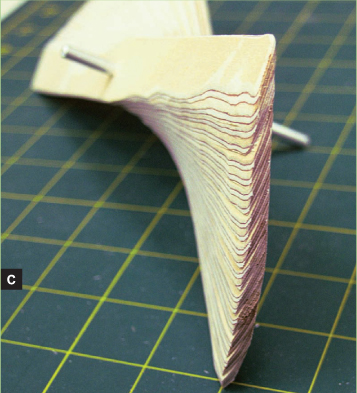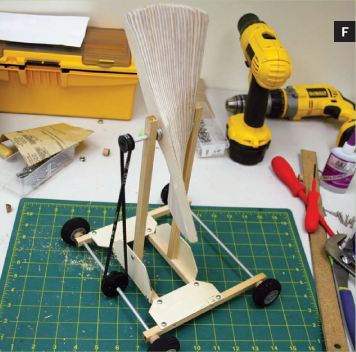
PROPELLER POWER Can a wind-powered vehicle travel faster than the wind propelling it? MAKE built one to find out.
Photography by Charles Platt
The Little Cart That Couldn’t
Wind-powered vehicle claims look like hot air.
Can a wind-driven vehicle outrun a tailwind? A Florida tinkerer named Jack Goodman claims it can, and he put a video on YouTube to prove it. Some sailing enthusiasts became convinced that he was on to something, while others were equally sure it was a hoax — and I decided to put it to the test.
HOW BOATS WORK
First, we need a quick primer on seafaring aerodynamics. The oldest boats had rectangular sails that were simply pushed by the wind. This system prevailed for about 4,000 years, until the 9th century A.D., when some inventive mariners found that a triangular sail enabled boats to move into a headwind at an angle, and when the sail pivoted around a mast, they could turn back and forth to tack a zigzag path directly upwind.
Figure 1 (page 62) shows a sailboat traveling north, into a wind blowing from the northwest. If the mariner adjusts his sail at a shallow angle to the breeze, the air creates a force that can be split into two components, one pushing the boat ahead, the other trying to push it sideways. If the boat has a rudder and a keel to fight the sideways force, it moves ahead. The sail’s forward curve also acts as an airfoil, slowing the air in back while forcing it to move faster around the front. This adds lift to the forward force.
The idea of sailing into a partial headwind seems counterintuitive, as if we’re getting something for nothing. Perhaps this explains why some boating folk seemed so willing to believe Jack Goodman’s surprising claim. And because triangular sails lose their advantages in a tailwind, modern boats do better sailing across the wind than dead downwind, when you might think a boat would go the fastest.
Given how effectively boats travel upwind, and that they can even exceed wind speed while running across the wind, it seems unfair that when they go the same direction as the wind they’ll never overtake it. Thus, when Goodman claimed he had a way to overcome the frustration of being overtaken by a tailwind, people were predisposed to listen.
To demonstrate his idea, he built a three-wheeled cart on which he mounted a big, homemade propeller, with its shaft connected to the rear wheels via a toothed belt. He made a video (makezine.com/go/jackgoodman) showing this contraption rolling along, first in response to a tailwind, and then, amazingly, moving faster than the tailwind, as demonstrated by a flag hanging in back. Note that if this happens, the vehicle begins to encounter a slight headwind relative to its motion.
Goodman claimed that the cart could do this because its wheels turned the propeller, which pulled it forward. This was somewhat puzzling because there was no power to turn the wheels. Was he just telling whoppers and pranking his sailing buddies? In the video, it all seemed to work, leading many people to believe that a guy in a garage in Florida had come up with something that had never occurred to anyone else in the history of boats and aviation, from the ancient Greeks through Leonardo da Vinci and on up to Northrop Grumman.
Clearly, it was time to build the MAKE version.
THE WIND TEST
Instead of a full-sized replica, I constructed a tabletop model. It would be easier to test and should perform better, since a size reduction creates a lower, more favorable, ratio of mass to surface area.
MATERIALS

[A] Sandpaper
[B] File
[C] 12" square of 3/32" plywood
[D] ⅜"×⅜" hardwood
[E] 3/16" diameter aluminum rod
[F] Landing wheels for model airplanes (4)
[G] #4 screws, 1" long
[H] Pieces of ½" dowel
[I] Toothed belt with 2 plastic gear wheels
[J] Power drill and various bits
[K] Cyanoacrylic glue
[L] #11 X-Acto knife
[M] Screwdriver
[N] Pliers
NOTE: Most of these items were bought at a hobby shop.
I found all the necessary materials at a local hobby shop. The crucial items were a toothed belt and two plastic gear wheels, sold as spare parts for a model car. If you want to build your own cart, a plain belt will be sufficient because very little torque is involved.
To fabricate the propeller, I did what Goodman seemed to have done. I stacked a dozen wooden strips, rotating each one about 4° before adding it to the rest. This creates a very wide blade, which should work well at slow speeds. I used cyanoacrylic (aka “Krazy”) glue to hold the layers together, and then smoothed them with a belt sander.
I sprayed copious amounts of WD-40 on anything that moved, then pushed the cart manually to make sure the wheels and propeller turned freely. I had to loosen the belt slightly so that it didn’t create friction by pulling the shafts against their bearings. Finally, I put the cart on a workbench and subjected it to a blast of air from a 15" room fan.
The belt on the cart has a 90° twist in it. Depending on which way you make the twist, a tailwind from behind the propeller will either turn the wheels forward, so that the cart moves with the wind, or backward, so that it tries to reverse itself into the wind. With the belt twisted to enable forward motion, the cart barely moved in response to the fan. When I twisted the belt the other way, the cart didn’t move at all.
Maybe I needed a bigger fan. I dragged in a 38" monster used for ventilating large warehouse spaces. Even with the new fan running at high speed, the cart ignored it and did nothing. Theorizing that the blast of air was too dispersed, I made a shroud to funnel the air and increase its speed, aiming it point-blank at the cart.
When I twisted the belt to make the cart run forward, it started moving at about 2" per second. This was not very impressive, since the air was moving at about 30’ per second.
I twisted the belt the other way, and now the cart was just able to back up into the wind, which was interesting. The propeller was driving a small gear that connected by a belt to a larger gear, and this gave the wheels just enough mechanical advantage against the floor to overcome the wind pressure on the vehicle.

Fig. A: To make the propeller, cut 1"×10" strips of 3/32" plywood, drill a center hole, and stack the strips on the 3/16" aluminum rod, turning each one slightly before gluing it.

Fig. B: The propeller completed, before sanding.

Fig. C: The propeller profile after sanding.

Fig. D: To join the sections of the frame, drill ample guide holes before driving in #4 screws.

Fig. E: The frame completed, with plywood gussets. The uprights bend apart just enough to insert the propeller on its shaft. Holes for the shafts should be 7/32" to allow them to turn freely.

Fig. F: The completed cart, ready for testing. Plastic gears are attached to the shafts with cyanoacrylic glue. The wheels are a tight push-fit. The belt must be relatively loose to minimize shaft friction.

Fig. 1: SAILING INTO THE WIND
Wind (blue arrow) bounces off sail (black line) creating a force (gray arrow). The force is equivalent to two perpendicular forces (red and green arrows). The dotted rectangle shows how to calculate their strengths. The keel and the rudder of the boat oppose the lateral force, leaving the boat experiencing a net force forward. Since the wind strikes the sail over a large area, the total forward force is larger than this diagram suggests.

Fig. 2: REVERSING THE PROPELLER’S SPIN
A tailwind will turn the propeller one way, while a headwind will turn it the other way. To make the cart continue moving forward, the belt configuration must be changed at the point where the cart outruns a tail-wind and encounters a net headwind.
Illustrations by Charles Platt
The cart crawled backward about an inch, and then stopped. I had been running the fan on medium, so I increased it to high, at which point it ripped the shroud off and blew it across the room. That was the end of the wind test.
AND YET IT MOVES!
Then I tried one more experiment. I attached a nylon thread to the cart and towed it along without bothering to blow air at it at all. Now the cart looked as if it was really cranking. In fact, it looked just like the YouTube video of Goodman’s cart!
When I took another look at this video, I noticed that he framed it so that you never see the road more than a couple of feet in front of his cart. This made me wonder. Did he, perhaps, have a bicycle just off-camera, dragging the cart on a piece of fishing line?
What made me suspicious was not just the hopeless performance of my own model, but the belt-twisting issue. Figure 2 illustrates the problem. You can’t have it both ways: if you twist the belt to make use of a tailwind, it won’t work in a headwind, and vice versa. To get the cart rolling, you have to put it in tailwind mode. Let’s suppose the wind diminishes suddenly, so that the cart is now running faster than the wind. In other words, it starts to experience a net headwind. The propeller will now blow into the wind, stopping the cart in its tracks, unless you reverse the belt to take advantage of the headwind.
In the Goodman video, no one touches the belt, no gears shift when wind speed is achieved. Yet his cart just trundles along without any concern for what the wind is doing, as if — well, as if it is being moved by some other force entirely.
Perhaps Jack Goodman has some clever explanation for this. Perhaps I didn’t build my version exactly the same way that he built his. Perhaps you should build your own, just to make sure. Building a prototype that doesn’t work is always educational, provided, of course, that you are willing to face facts and admit that it doesn’t work.
But if you decide to fake it and post a video that makes it seem to work, causing excitement and argument while spreading delusionary ideas, that is not what I would call educational.
Charles Platt is a frequent contributor to MAKE, has been a senior writer for Wired, and has written science fiction novels, including The Silicon Man.

BLOWING IN THE WIND TOP: A 38" fan failed to move the cart either forward or backward.

With a shroud to funnel the air from the same fan, the cart edged forward at about 2" per second. The air was blowing at about 30’ per second. Outrunning a tailwind? No way.
